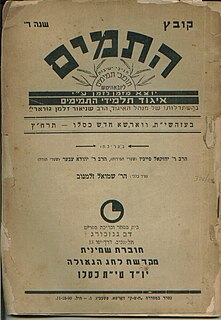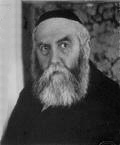Memorial

The tomb of Sheina's older sister, Chaya Mushka Schneerson, contains a dedication to her death during the holocaust. The tomb is visited regularly by Chabad Hasidim. [7]
Shaina Horenstein | |
|---|---|
| Born | Shaina Schneersohn |
| Died | 2nd Day of Rosh Hashanah, September 13, 1942 |
| Spouse(s) | Menachem Mendel Horenstein |
| Parent(s) | Yosef Yitzchak and Nechama Dinah Schneersohn |
Shaina Horenstein (1904-1942) was the youngest daughter of Rabbi Yosef Yitzchak Schneersohn, the sixth Rebbe of the Chabad Hasidic movement. In the Chabad community, she is referred to as Rebbitzin Shaina. [1]
Sheina Horenstein was born Sheina Schnnersohn, the youngest daughter of Rabbi Yosef Yitzchak Schneersohn, the sixth Rebbe of the Chabad, and Nechama Dinah Schneersohn. As with many members of the Schneersohn dynasty, Sheina is referred to as "Rebbitzin Sheina" by many Chabad Hasidim.
Rebbitzin Sheina moved to Paris in 1932 and married Menachem Mendel Horenstein on Tuesday, June 14, 1932 (Hebrew: Sivan 10, 5692). [2] Her wedding was attended by many notable rabbis and Hasidic Rebbes. [3] The couple lived near Rabbi Yosef Yitzchak in Poland for a number of years and were permanent members of his court.
Sheina and her husband were killed by the Nazis during World War II in Treblinka. [4] [5] Mordechai Unrad testified that he had been in Treblinka with the Horensteins and that Sheina was killed on the 2nd Day of Rosh Hashanah, 1942. [6]

The tomb of Sheina's older sister, Chaya Mushka Schneerson, contains a dedication to her death during the holocaust. The tomb is visited regularly by Chabad Hasidim. [7]

Menachem Mendel Schneerson, known to many as the Lubavitcher Rebbe or simply the Rebbe, was a Russian-Empire-born American Orthodox rabbi, and the most recent rebbe of the Lubavitch Hasidic dynasty. He is considered one of the most influential Jewish leaders of the 20th century.

Menachem Mendel Schneersohn also known as the Tzemach Tzedek was an Orthodox rebbe, leading 19th-century posek, and the third rebbe of the Chabad Lubavitch Hasidic movement.

Yosef YitzchakSchneersohn was an Orthodox rabbi and the sixth Rebbe of the Chabad Lubavitch Chasidic movement. He is also known as the Frierdiker Rebbe, the Rebbe RaYYaTz, or the Rebbe Rayatz. After many years of fighting to keep Orthodox Judaism alive from within the Soviet Union, he was forced to leave; he continued to conduct the struggle from Latvia, and then Poland, and eventually the United States, where he spent the last ten years of his life.

Schneersohn is a Jewish surname used by many of the descendants of the Rabbi Shneur Zalman of Liadi, the first Rebbe of the Chabad-Lubavitch Hasidic movement.
Chaya Mushka (Moussia) Schneerson, referred to by Lubavitchers as The Rebbetzin, was the wife of Rabbi Menachem Mendel Schneerson, the seventh and last Rebbe of the Chabad-Lubavitch branch of Hasidic Judaism. She was the second of three daughters of the sixth Lubavitcher Rebbe, Rabbi Yosef Yitzchok Schneersohn. She was named after the wife of the third Lubavitcher Rebbe, Rabbi Menachem Mendel Schneersohn.

Rabbi Shemaryahu Gurary, also known by his Hebrew initials as Rashag, (1897-1989) was an Orthodox rabbi belonging to the Chabad-Lubavitch Hasidic movement. His father was Rabbi Menachem Mendel Gurary. He was the older son-in-law of Rabbi Yosef Yitzchok Schneersohn (1880-1950), known as Rebbe Rayatz, the sixth Rebbe of the Chabad-Lubavitch Hasidic movement, and the brother-in-law of Rabbi Menachem Mendel Schneerson (1902-1994), the seventh Lubavitcher Rebbe. He worked with his father-in-law in communal service in both Russia and Poland and then arrived in the U.S. in 1940, where he continued this work until his death. Gurary had a comprehensive knowledge of Chassidic philosophy and was a devoted follower of his father-in-law Rabbi Yosef Yitzchak Schneersohn, and later of his brother-in-law Rabbi Menachem Mendel Schneerson.

The Kopust branch of the Chabad Hasidic movement was founded in 1866 by Rabbi Yehuda Leib Schneersohn after the death of the third rebbe of Chabad, Rabbi Menachem Mendel Schneersohn. The movement is named after the town Kopys in the Vitebsk Region of present-day Belarus, where Rabbi Yehuda Leib Schneersohn settled after his father's death.

Chitas is a Hebrew acronym for Chumash, Tehillim (Psalms), and Tanya. These are considered basic Jewish texts according to the Chabad Jewish community, an ultra-orthodox Chasidic group. They have the custom to study these works according to a yearly cycle, which is known colloquially as "doing ChiTaS."

The Library Of Agudas Chassidei Chabad is a research library owned by Agudas Chasidei Chabad. Its content had been collected by the Chabad-Lubavitch Rebbes. The library is housed next to the Lubavitch world headquarters at 770 Eastern Parkway in Brooklyn, New York, and is utilized by Chabad and general Judaic scholars. It is viewed by thousands of visitors each year.

Yehuda Leib "Leibel" Groner was an American Hasidic Jewish teacher, scholar, and author. He is best known for having served as the personal secretary to Rabbi Menachem Mendel Schneerson, the seventh Lubavitcher Rebbe, for 40 years.
Chana Schneerson was the wife of Rabbi Levi Yitzchak Schneerson, a Chabad Hasidic rabbi in Yekatrinoslav, Ukraine and the mother of the seventh Chabad-Lubavitch Rebbe, Rabbi Menachem Mendel Schneerson.

Chabad offshoot groups are those spawned from the Chabad Hasidic Jewish movement. Many of these groups were founded to succeed previous Chabad leaders, acting as rivals to some of the dynastic rebbes of Chabad. Others were founded by former students of the movement, who, in forming their own groups, drew upon their experiences at Chabad.

Chabad philosophy comprises the teachings of the leaders of Chabad-Lubavitch, a Hasidic movement. Chabad Hasidic philosophy focuses on religious concepts such as God, the soul, and the meaning of the Jewish commandments.

Chabad customs and holidays are the practices, rituals and holidays performed and celebrated by adherents of the Chabad-Lubavitch Hasidic movement. The customs, or minhagim and prayer services are based on Lurianic kabbalah. The holidays are celebrations of events in Chabad history. General Chabad customs, called minhagim, distinguish the movement from other Hasidic groups.
Chaya Mushka Schneersohn was the daughter of Rabbi Dovber Schneuri, the second Rebbe of the Chabad Hasidic movement, and the wife of Rabbi Menachem Mendel Schneersohn the third Rebbe.

Hatomim was a scholarly journal published by the Chabad-Lubavitch Hasidic movement. The journal was published under the direction of the sixth Rebbe of Chabad, Rabbi Yosef Yitzchak Schneersohn. The journal published articles on Chabad philosophy and Talmud.
Chof Beis Shvat, the 22nd day of the month of Shvat in the Hebrew calendar is the yartzeit of Rebbetzin Chaya Mushka Schneerson, married to the seventh Rebbe of the Chabad Hasidic movement. The day is marked by the Chabad community with public gatherings and other commemorations.

Yud Beis–Yud Gimmel Tammuz, the 12th and 13th days of Tammuz on the Hebrew calendar, are celebrated as a holiday by the Chabad Hasidic community. The holiday commemorates the liberation of Rabbi Yosef Yitzchak Schneersohn, the sixth Chabad Rebbe, from Soviet imprisonment. Schneersohn was born June 21, 1880. The day is marked by public gatherings, additional study and prayer.
Yud Shvat is a significant date on the Chabad Hasidic calendar. It is the yahrtzeit or anniversary of passing of the sixth Chabad Rebbe, Rabbi Yosef Yitzchak Schneersohn (1880–1950). The day also marks the formal acceptance of leadership in 1951 by the seventh Rebbe, Rabbi Menachem Mendel Schneerson (1902–1994). On Yud Shvat, Rabbi Menachem Mendel formally accepted the leadership of Chabad-Lubavitch movement with a public address and Hasidic discourse (maamar) at a gathering marking the first anniversary of his predecessor’s passing.

Yisroel Jacobson (1895-1975) was a Chabad Hasidic rabbi and the representative of the sixth Chabad Rebbe, Rabbi Yosef Yitzchak Schneersohn, to the United States during the 1920s and 1930s. Rabbi Jacobson was one of the first Lubavitcher activists to arrive in to the United States. He was born in Russia and migrated to the United States in 1925.